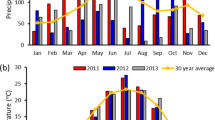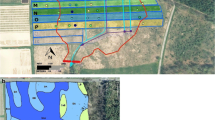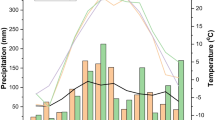Abstract
Emphasis is trending toward future bioenergy production being derived from cellulosic materials rather than starch from seed crops. The majority of research on perennial biomass production for conversion to ethanol or other biofuel has used warm-season grasses as the feedstock material. Some cool-season grasses also have great potential for biomass production, even in the southern prairie region. A study was conducted for 4 years to evaluate the dry matter production potential of several cool-season grass cultivars in west-central Kansas. Ten cultivars were grown at two locations, one an upland soil and the other a lowland soil, and harvested in late June from 2007 to 2010 when fully headed with mature seed. Three cultivars, one tall [Thinopyrum ponticum (Podp.) Barkw. & D.R. Dewey], intermediate [T. intermedium (Host) Barkw. & D.R. Dewey], and western wheatgrass [Pascopyrum smithii (Rydb.) Love], had the greatest biomass production with 4,525–4,840 kg ha−1 dry matter averaged over four years at an upland location. At a lowland location, three cultivars, either intermediate or tall wheatgrasses, averaged 5,340–5,490 kg ha−1 dry matter over the 4 years. During the particularly moist spring of 2007, three cultivars at the upland location and eight cultivars at the lowland location produced over 9,000 kg ha−1 dry matter. All cultivars increased in plant stand frequency from 2006 to 2011, except for the western wheatgrass and Russian wildrye [Psathyrostachys juncea (Fisch.) Nevski] cultivars that already had a high frequency before the first biomass harvest. These grasses may add versatility to production systems by not only serving as complementary forage for grazing or hay, but also by providing an alternative feedstock for cellulosic ethanol and combustion energy production.
Similar content being viewed by others
References
Boe A, Lee DK (2007) Genetic variation for biomass production in prairie cordgrass and switchgrass. Crop Sci 47:929–934
Casler MD (2005) Ecotypic variation among switchgrass populations from the Northern USA. Crop Sci 45:388–398
Casler MD, Cherney JH, Brummer EC (2009) Biomass yield of naturalized populations and cultivars of reed canary grass. BioEnergy Res 2:165–173
Cassida KA, Muir JP, Hussey MA (2005) Biofuel component concentrations and yields of switchgrass in South Central U.S. environments. Crop Sci 45:682–692
Frank AB, Ray IM, Berdahl JD (1997) Carbon isotope discrimination, ash, and canopy temperature in three wheatgrass species. Crop Sci 37:1573–1576
Gillen RL, Berg WA (2005) Response of perennial cool-season grasses to clipping in the southern plains. Agron J 97:125–130
Goering HK, Van Soest PJ (1970) Forage fiber analyses. USDA Agr Handbook 379. USDA, Washington, D.C, pp. 387–598
Great Plains Agricultural Council (1966) A stand establishment survey of grass plantings in the Great Plains. Nebraska Agric Exp Stn, Great Plains Council Report 23
Harmoney KR (2005) Growth responses of perennial cool-season grasses grazed intermittently. Forage Grazinglands. doi:10.1094/FG-2005-0105-01-RS
Harmoney KR (2007) Persistence of heavily-grazed cool-season grasses in the central great plains. Forage Grazinglands. doi:10.1094/FG-2007-0625-01-RS
Harmoney KR, Thompson CA (2010) Using long-term relative yield and quality to select adapted small grain forages. Forage Grazinglands. doi:10.1094/FG-2010-0125-01-RS
Hartmann H, Maier L, Bohm T (1999) Quality of solid biofuels—database and field trials. In: R.P. Overend and E. Chornet (eds) Proc. Biomass Conf. of the Americas, 4th, Oakland, CA. 29 Aug.–2 Sept. 1999. Vol 1 Elsevier Sci, Oakland, CA. pp 273–279
Hendrickson JR, Berdahl JD, Liebig MA, Karn JF (2005) Tiller persistence of eight intermediate wheatgrass entries grazed at three morphological stages. Agron J 97:1390–1395
Hopkins AA (2005) Grazing tolerance of cool-season grasses planted as seeded sward plots and spaced plants. Crop Sci 45:1559–1564
Karn JF, Berdahl JD, Frank AB (2006) Nutritive quality of four perennial grasses as affected by species, cultivar, maturity, and plant tissue. Agron J 98:1400–1409
Launchbaugh JL (1971) Upland seeded pastures compared for grazing steers at Hays, Kansas. Kansas State University Agricultural Experiment Station, Manhattan, KS. Bulletin 548
Lee D, Aberle E, Chen C, Egenolf J, Harmoney K, Kakani G et al (2013) Nitrogen and harvest management of Conservation Reserve Program (CRP) grassland for sustainable biomass feedstock production. GCB Bioenergy 5:6–15. doi:10.1111/j.1757-1707.2012.01177.x
Lewandowski I, Clifton-Brown JC, Andersson B, Basch G, Christian DG, Jørgensen U et al (2003) Environment and harvest time affects the combustion qualities of miscanthus genotypes. Agron J 95:1274–1280
Malinowski DP, Hopkins AA, Pinchak WE, Sij JW, Ansley RJ (2003) Productivity and survival of defoliated wheatgrasses in the Rolling Plains of Texas. Agron J 95:614–626
Mohammed YA, Chen C, Lee DK (2013) Harvest time and nitrogen fertilization to improve bioenergy feedstock yield and quality. Agron J 106:57–65
Monono EM, Nyren PE, Berti MT, Pryor SW (2013) Variability in biomass yield, chemical composition, and ethanol potential of individual and mixed herbaceous biomass species grown in North Dakota. Ind Crop Prod 41:331–339
Mulkey VR, Owens VN, Lee DK (2006) Management of switchgrass-dominated conservation reserve program lands for biomass production in South Dakota. Crop Sci 46:712–720
Sanderson MA, Adler PR (2008) Perennial forages as second generation bioenergy crops. Int J Mol Sci 9:768–788. doi:10.3390/ijms9050768
SAS Institute, Inc (1996) SAS system for mixed models. Cary, NC
Tahir M, Casler MD, Moore KJ, Brummer E (2010) Biomass yield and quality of reed canarygrass under five harvest management systems for bioenergy production. BioEnergy Res 4:111–119
USDA (2013) Crop production: acreage. National Agricultural Statistics Service, Washington, D.C., p 41
USDA (2014) PLANTS Database. http://plants.usda.gov
Vogel KP, Masters RA (2001) Frequency grid - a simple tool for measuring grassland establishment. J Range Manag 54:653–655
Vogel KP, Pedersen JF, Masterson SD, Toy JJ (1999) Evaluation of a filter bag system for NDF, ADF, and IVDMD forage analysis. Crop Sci 39:276–279
Waller SS, Moser LE, Anderson B (1986) A guide for planning and analyzing a year- round forage program. Nebraska Cooperative Extension Bulletin EC 86-113-C. University of Nebraska, Lincoln
Yau SK, Hamblin J (1994) Relative yield as a measure of entry performance in variable environments. Crop Sci 34:813–817
Author information
Authors and Affiliations
Corresponding author
Additional information
Contribution no. 14-073-J from the Kansas Agricultural Experiment Station.
Rights and permissions
About this article
Cite this article
Harmoney, K.R. Cool-Season Grass Biomass in the Southern Mixed-Grass Prairie Region of the USA. Bioenerg. Res. 8, 203–210 (2015). https://doi.org/10.1007/s12155-014-9514-9
Published:
Issue Date:
DOI: https://doi.org/10.1007/s12155-014-9514-9




